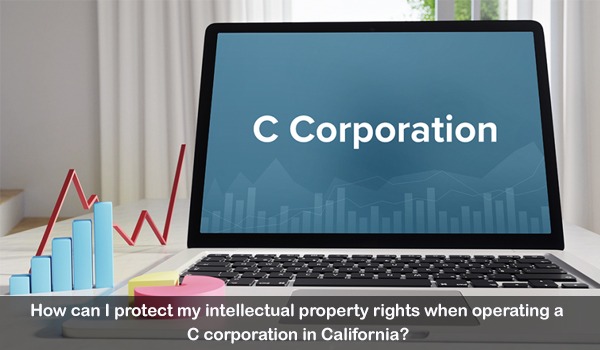How can I protect my intellectual property rights when operating a C corporation in California?

Protecting intellectual property (IP) rights is crucial for businesses operating as C corporations in California. As a state known for its thriving innovation and technology sectors, safeguarding your IP can be the key to maintaining a competitive edge and ensuring long-term success. This article provides a comprehensive guide on how C corporations can effectively protect their intellectual property rights in California, offering insights and strategies to navigate this complex legal landscape.
In the context of business and law, intellectual property (IP) refers to intangible creations of the human intellect that possess commercial value. It encompasses a broad range of innovative and creative expressions that individuals or organizations have the exclusive right to use and control. Intellectual property rights grant legal protections to creators and owners, allowing them to monetize and safeguard their intangible assets.
Intellectual property can take various forms, including inventions, artistic works, designs, symbols, names, and proprietary knowledge. It is important to understand that intellectual property is distinct from physical property, such as land or buildings, as it primarily focuses on the intangible aspects of creations and ideas.
The core purpose of intellectual property rights is to encourage and incentivize innovation, creativity, and investment in research and development. By providing legal protections, intellectual property rights enable individuals and businesses to have a competitive advantage in the market, generate revenue from their creations, and maintain control over the use and exploitation of their intangible assets.
Types of Intellectual Property
There are four main types of intellectual property recognized under legal systems worldwide. Each type offers specific rights and protections to creators, innovators, and businesses, depending on the nature of their creations.
- Copyrights: Copyrights safeguard original works of authorship that are expressed in a tangible form. These works encompass various forms of creative expression, such as literature, music, visual arts, films, software code, and architectural designs. Copyright holders have exclusive rights to reproduce, distribute, perform, display, and modify their works. Copyright protection is automatic upon creation, but registering with relevant authorities provides additional benefits and strengthens legal enforcement.
- Trademarks: Trademarks are symbols, designs, logos, phrases, or words that distinguish and identify goods or services from a particular source. They serve as indicators of brand identity and reputation. Trademark protection grants exclusive rights to use and prevent others from using similar marks in the same or related industries. Registering a trademark with the appropriate intellectual property office provides stronger legal protection and nationwide recognition.
- Patents: Patents protect inventions and provide inventors with exclusive rights for a limited period. An invention can be a new product, process, or technology that offers a new solution to a problem or provides a technical advancement. Patent protection prevents others from making, using, selling, or importing the patented invention without permission. Obtaining a patent involves disclosing the invention's details to the patent office and meeting specific criteria for novelty, non-obviousness, and industrial applicability.
- Trade Secrets: Trade secrets are confidential and proprietary information that gives a business a competitive advantage. This can include formulas, manufacturing processes, customer lists, software algorithms, or other confidential business information. Unlike copyrights, trademarks, and patents, trade secrets are protected through non-disclosure agreements (NDAs) and strict internal controls. Trade secret protection relies on maintaining secrecy and preventing unauthorized access or disclosure.
Registering Intellectual Property
Registering intellectual property is an essential step for businesses and creators to secure legal protections and maximize the benefits of their intangible assets. While some forms of intellectual property protection, such as copyrights, are automatic upon creation, registering intellectual property with the relevant authorities offers additional advantages and strengthens the legal enforcement of rights. Let's explore the process and benefits of registering different types of intellectual property.
Copyright Registration
Copyright protection exists automatically upon the creation of an original work of authorship. Copyright protection is available to creative works, such as music, literature, web content, software, and more. In order to receive copyright protection, you must register your work with the United States Copyright Office. This registration provides you with the rights to your intellectual property and serves as evidence that you're the rightful owner of the work. If someone attempts to use your work without permission, you can take legal action against them. However, registering copyrights with the appropriate copyright office provides several benefits:
- Establishing a Public Record: Registering a copyright creates a public record of ownership and serves as evidence of your rights. It helps prevent disputes over authorship or ownership of the work.
- Presumption of Validity: Copyright registration offers a presumption of validity for both the copyright itself and the information documented in the registration certificate. This presumption holds significant value in legal proceedings, particularly in cases of infringement. By having a registered copyright, you gain an advantage in simplifying the legal process and asserting your rights in a more straightforward manner.
- Eligibility for Statutory Damages and Attorney's Fees: Registering copyright prior to infringement or within a specific time frame allows copyright holders to claim statutory damages and attorney's fees in case of successful litigation.
- Enhanced Legal Protection: Copyright registration is a prerequisite for filing a copyright infringement lawsuit in federal court. It provides additional legal remedies and enforcement options.
The procedure for copyright registration may vary depending on the jurisdiction, but it typically entails submitting an application, a copy of the work, and the requisite fee to the designated copyright office. In the United States, the U.S.Copyright Office oversees the process of copyright registration.
Trademark Registration
Trademark registration protects brands, logos, symbols, names, and phrases that distinguish goods or services in the marketplace. Registering a trademark offers the following advantages:
- Exclusive Rights and Nationwide Protection: Trademark registration provides exclusive rights to use the mark in connection with specific goods or services nationwide. It helps prevent others from using similar marks that may cause confusion among consumers.
- Legal Presumption of Ownership and Validity: Registered trademarks enjoy a legal presumption of ownership and validity, making it easier to enforce rights and resolve disputes.
- Notice to Others: Registered trademarks include the use of the ® symbol, which provides notice to others of your exclusive rights. This can deter potential infringers and strengthen your brand's position.
To register a trademark, the process typically involves conducting a thorough search to ensure the mark is available, preparing the application, submitting it to the relevant trademark office (e.g., United States Patent and Trademark Office in the U.S.), and paying the required fees. The application may require details about the mark, its use, and a description of the associated goods or services.
Patent Registration
Patent registration is crucial for protecting inventions, processes, and technologies. While the process for obtaining a patent can be complex and time-consuming, it offers significant benefits:
- Exclusive Rights: Patent registration grants the inventor exclusive rights to make, use, sell, or import the invention for a specified period, typically 20 years from the filing date. This exclusivity provides a competitive advantage and the opportunity to capitalize on the invention.
- Legal Protection and Enforcement: Registered patents offer stronger legal protections and remedies against infringement. Patent owners can file infringement lawsuits to defend their rights and seek damages.
- Market Advantage and Licensing Opportunities: Patents can serve as valuable assets, providing a competitive edge in the market. Patent holders can license or sell their patents to generate revenue and establish strategic partnerships.
The process of obtaining a patent involves conducting a thorough patent search to ensure the invention is novel and non-obvious, preparing a detailed patent application with supporting documents, and filing it with the relevant patent office. The application undergoes examination, which may include back-and-forth communication with patent examiners, before a decision on granting the patent is reached.
Trade Secret Protection
Unlike copyrights, trademarks, and patents, trade secrets are not registered with any government office. Instead, trade secret protection relies on maintaining secrecy and implementing appropriate security measures. However, businesses can take several steps to safeguard their trade secrets:
- Identify and Document Trade Secrets: Businesses should identify and document their trade secrets, clearly defining what information is considered confidential and valuable.
- Non-Disclosure Agreements (NDAs): NDAs are essential tools for protecting trade secrets. Businesses should use NDAs with employees, contractors, and other parties who may come into contact with confidential information.
- Employee and Contractor Confidentiality Agreements: Implementing confidentiality agreements specific to employees and contractors helps ensure they understand their obligations regarding trade secret protection.
By effectively registering intellectual property, businesses and creators can enhance their legal protections, establish a public record of ownership, and assert their rights more effectively. It is advisable to consult intellectual property attorneys or professionals familiar with the relevant laws and processes to navigate the registration requirements specific to each type of intellectual property and jurisdiction.
Enforcing Intellectual Property Rights
Enforcing intellectual property (IP) rights is crucial to protect the value of your creations and prevent unauthorized use or infringement. When someone infringes upon your IP rights, taking appropriate enforcement actions can help safeguard your competitive advantage and preserve your economic interests. Let's explore the key aspects of enforcing intellectual property rights:
- Monitoring and Detection: Conducting regular IP audits allows you to identify potential infringement and ensure compliance within your organization. It involves reviewing your IP portfolio, monitoring marketplace activities, and assessing internal practices to detect any unauthorized use or potential threats.
- Online Monitoring Tools: Utilize online monitoring tools and services to track and identify instances of IP infringement on various platforms, including websites, social media, and online marketplaces. These tools can help automate the detection process and provide you with alerts or reports on potential infringements.
- Cease and Desist Letters: Cease and desist letters serve as a formal notification to individuals or businesses engaging in infringing activities. The letter asserts your rights, demands the immediate cessation of infringing activities, and may include a request for compensation or damages. Cease and desist letters are often the first step in resolving IP disputes before pursuing legal action.
- Crafting an Effective Cease and Desist Letter: When drafting a cease and desist letter, it is important to clearly state the basis for your claims, provide evidence of the infringement, specify the actions required to remedy the infringement, set a reasonable deadline for compliance, and indicate potential legal consequences if the infringement continues.
- Litigation and Legal Remedies: Copyright and Trademark Infringement Lawsuits: If infringement persists or is particularly severe, initiating a lawsuit in a civil court may be necessary. Copyright and trademark infringement lawsuits typically seek injunctions to stop the infringing activities, monetary damages, and potential recovery of legal costs.
- Patent Infringement Lawsuits: Patent infringement lawsuits can be complex and require expert legal counsel. Remedies sought may include injunctions, monetary damages, and, in some cases, the possibility of seeking treble damages (i.e., triple the amount of actual damages) if the infringement is proven to be willful.
- Trade Secret Misappropriation Lawsuits: Trade secret misappropriation lawsuits involve legal action against individuals or entities that have unlawfully acquired, used, or disclosed trade secrets. Remedies may include injunctive relief, monetary damages, and potential disgorgement of profits obtained through the misappropriation.
Enforcing IP rights through litigation can be a time-consuming and costly process. It is advisable to consult with an experienced intellectual property attorney who can assess the merits of your case, guide you through the legal procedures, and help you determine the most appropriate course of action.
It is worth noting that alternative dispute resolution methods, such as mediation or arbitration, can also be explored as cost-effective and efficient means of resolving IP disputes outside of traditional litigation.
Contractual Protections for Intellectual Property
Contractual protections for intellectual property (IP) are essential for businesses and creators to establish clear rights and obligations regarding the use, disclosure, and ownership of IP assets. These contractual agreements help mitigate the risk of IP disputes, provide legal remedies in case of infringement, and facilitate the licensing or transfer of IP rights. Let's delve into the key aspects of contractual protections for IP:
Non-Disclosure Agreements (NDAs)
Unlike copyrights, trademarks, and patents, trade secrets are not registered with any government office. Instead, trade secret protection relies on maintaining secrecy and implementing appropriate security measures. However, businesses can take several steps to safeguard their trade secrets:
- Purpose and Importance: NDAs, also known as confidentiality agreements, are fundamental contractual tools for protecting confidential information, trade secrets, and proprietary knowledge. They establish a confidential relationship between parties and set forth the terms and conditions under which sensitive information can be shared.
- Key Provisions: NDAs commonly incorporate several essential provisions to effectively safeguard confidential information. These provisions encompass defining confidential information, outlining confidentiality obligations, specifying authorized usage and disclosure, including non-compete clauses, determining the duration of the agreement, and establishing mechanisms for dispute resolution. It is crucial to customize the NDA to align with the unique requirements of the parties involved and the nature of the confidential information being protected.
Licensing and Assignment Agreements
- Licensing IP Rights: Licensing agreements allow IP owners to grant others permission to use their IP assets in exchange for agreed-upon terms and conditions. These agreements can encompass copyrights, trademarks, patents, or trade secrets. Licensing agreements define the scope of the license, limitations on use, royalty payments, duration, termination clauses, and dispute resolution mechanisms.
- Assignment of IP Rights: Assignment agreements involve the transfer of IP rights from one party (assignor) to another (assignee). Assignments can be partial or complete and should be properly documented to ensure the transfer of ownership is legally valid. These agreements define the transferred rights, consideration or payment, warranties and representations, and any ongoing obligations.
- Franchise Agreements: In the case of franchising, franchise agreements serve as comprehensive contracts that outline the terms and conditions of using and operating a franchise business. These agreements cover a range of IP-related aspects, including the use of trademarks, proprietary processes, trade secrets, and other IP assets.
Working with Intellectual Property Attorneys
Working with intellectual property (IP) attorneys is crucial for businesses and individuals seeking to protect, enforce, or leverage their intellectual property rights. IP attorneys possess specialized knowledge and expertise in IP law and can provide valuable guidance throughout the process. Let's explore in detail how to effectively work with IP attorneys:
Identifying the Need for an IP Attorney
Determine the specific IP matters requiring legal assistance, such as patents, trademarks, copyrights, trade secrets, or licensing agreements.
- Assess the complexity of the IP issues involved, the potential risks, and the strategic value of your IP assets.
- Consider the resources available and the potential benefits of engaging an IP attorney to handle the legal aspects of IP protection and enforcement.
Selecting the Right IP Attorney
Seek recommendations from trusted sources, such as other professionals in the field, colleagues, or business associates who have worked with IP attorneys.
- Research the attorney's qualifications, experience, and expertise in the relevant area of IP law.
- Assess their track record in handling similar cases or matters and their success rate.
- Consider their understanding of your specific industry or business sector, as industry knowledge can be advantageous in navigating IP challenges effectively.
Collaborative Strategy Development
Collaborate with the IP attorney to develop a comprehensive IP strategy tailored to your specific objectives and circumstances.
- Discuss the various legal options available, potential risks, and the recommended course of action.
- Evaluate the costs associated with each option and weigh them against the potential benefits.
- Work with the attorney to prioritize actions based on your immediate and long-term goals.
Legal Services and Representation
Engage the IP attorney to provide the necessary legal services, such as drafting and reviewing contracts, conducting trademark searches, filing patent applications, or enforcing your IP rights.
- Ensure open and transparent communication with the attorney throughout the process, providing them with any additional information or updates relevant to your case.
- Promptly respond to requests for information or documentation to maintain the momentum of the legal proceedings.
- Regularly communicate with the attorney to stay informed about the progress of your case, potential challenges, and any new developments.
Remember that IP attorneys are legal professionals who specialize in IP matters, and their expertise can significantly impact the success of your IP-related endeavors. By establishing a collaborative and effective working relationship, you can leverage their knowledge and skills to protect and enforce your intellectual property rights effectively.
Conclusion
When running a C corporation in California, it is crucial to take necessary measures to safeguard your intellectual property rights. Key steps to achieve this include registering your trademarks and copyrights, creating agreements with third parties who handle your intellectual property, and familiarizing yourself with trade secret laws.
Seeking guidance from an attorney well-versed in intellectual property law is highly recommended to ensure consistent protection of your rights. Keep in mind that protecting your intellectual property is an ongoing commitment. Stay alert, take proactive measures, and seek expert advice to effectively navigate the intricacies of intellectual property law and safeguard your valuable intellectual assets for the long term.
Our Services
Sole Proprietorships and Partnerships
LLC or Corporation
C-Corporation
S-Corporation
Non-profit organization
Start an LLC corporation in California
Related blogs
Register a Company in the USA
A step-by-step guide to registering a business name in California
Protecting a business name in California
How to start an LLC corporation in California


